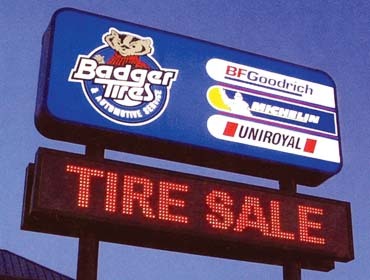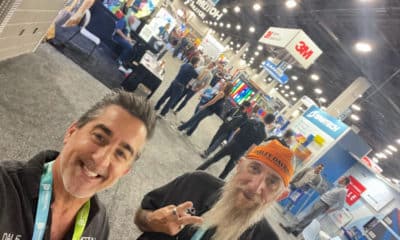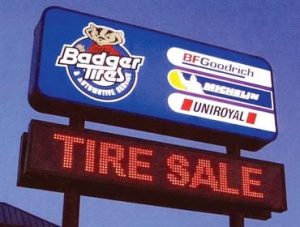Recently, I experienced an obvious revelation: Companies with an established, electronic-display, installation base, might not be terribly excited to upgrade old lamp displays to new, LED signs. Why? The older technology provided a steady stream of highly profitable maintenance business.
The replacement technologies don't. The new, low-maintenance technologies threaten companies that have committed equipment, inventory and manpower to lamp-maintenance programs.
Having never been on the maintenance side of the sign business, I hadn't realized the fiscal importance of an installation base of older signs. However, companies can lose much business if they don't apprise customers of developing technologies.
Sign companies nationwide derive consistent revenue from maintenance contracts with a 40 to 50%-profit margin. They've carved a nice niche business from fallible old systems, with dependable lamp changes, triac replacements and driver failures.
It was nobody's fault, just the nature of the product. In a decent-sized market, a sign company could annually count on installing five to 10 new lamp displays. Each display produced sales profit, but also, and perhaps more importantly, a reliable maintenance revenue stream for a decade or more.
Now, I finally understand some sign companies' reluctance to propose upgrades. For some reason, I just never made the connection. I would caution every affected company not to bury its head in the sand. It most certainly won't go away. Not only is the new technology here, but its providers outnumber those offering old lamp systems. Each new company has salespeople, armed with maintenance and electrical-comparison charts, to demonstrate to the customer the absolute "no brainer" aspect to the upgrade.
Advertisement
Worse, in some markets, "energy specialty" companies call on lamp-display owners with screw-in, low-energy, lamp replacements or LED lamps. These companies aren't trying to sell new displays. They're trying to place their technologies into existing signs. In the process, they eliminate the sign company's maintenance contract.
The bottom line: Competition for today's display maintenance largely focuses on replacement of the revenue streams itself.
So, what to do? The only hedge against business loss is staying ahead of the curve with your existing customer base to make certain an upgrade's potential merits are clear and, most importantly, that your company is best prepared to assist with the transition.
Granted, the upgrades will reduce maintenance dollars, but, if you've structured the maintenance contracts correctly, you should, at least, maintain your profit margin. Not only will you maintain new technology, it will be easier to perform and involve fewer replacement parts. Coupled with a reduction in maintenance-call frequency, these factors could, conceivably, increase your profit margin.
A successful LED-display maintenance program requires that you work with a manufacturer with a quality, rapid-response and support mechanism. Parts inventory and repair, and replacement turnaround are key factors.
When you acquire a display from the manufacturer, you should receive (at least) a 2% spare-parts inventory for the sign's first, failed components. However, although these parts are immediately available without added expense, the prudent company immediately sends the damaged or spent part to the repair center. Failure to do so will leave a gap in replacement inventory and a consequential repair delay once the spare-parts inventory is depleted. Further, any delay in parts replacement could exceed the parts' warranty period. Remember, new displays don't have expendable parts not covered under warranty. In lieu of lamps and triacs, use LED boards or modules, which should be warranted for one to five years, depending on the manufacturer.
Advertisement
New lamp displays' popularity stems from their dependability, lower cost, higher resolution and readability. Consequently, an astute sign company can offset any maintenance-revenue losses with increased sales. Vast, new-business markets are unveiling the value of on-premise, programmable advertising. If your focus remains on the old-style lamp technologies, you're likely to miss this evolution.
This new technology spawned another growing trend that should more than offset lost maintenance revenue. The new display growth now requires programming services. Many businesses would rather pay a monthly fee to professionally upgrade their display(s) than pay a controller and the specialized labor to program it. With economical, modern-day controllers and modems, the upfront cost to offer such services is minimal. This highly profitable add-on to your sale coincides perfectly with the thinking of many of today's display users.
Undoubtedly, the new technology requires some restructuring for business models wrapped around the old lamp displays. But, greater opportunity also exists for a cleaner, lower-labor-cost business focused on the new displays. On the surface, maintenance gross revenue will decrease, as will the actual
service provided for the remaining revenue. For an aggressive company, however, increased sales and ancillary services available through the newer technology should exceed such reductions.
Most importantly, recognize that your business doesn't operate in a vacuum. Competitors in the field increase daily. The best option is to offer your customers new technology with such new services as programming.


 Photo Gallery2 weeks ago
Photo Gallery2 weeks ago
 Paula Fargo2 weeks ago
Paula Fargo2 weeks ago
 Real Deal1 week ago
Real Deal1 week ago
 Photo Gallery2 weeks ago
Photo Gallery2 weeks ago
 Projects1 week ago
Projects1 week ago
 Business Management1 week ago
Business Management1 week ago
 News24 hours ago
News24 hours ago
 Dale Salamacha4 days ago
Dale Salamacha4 days ago
















